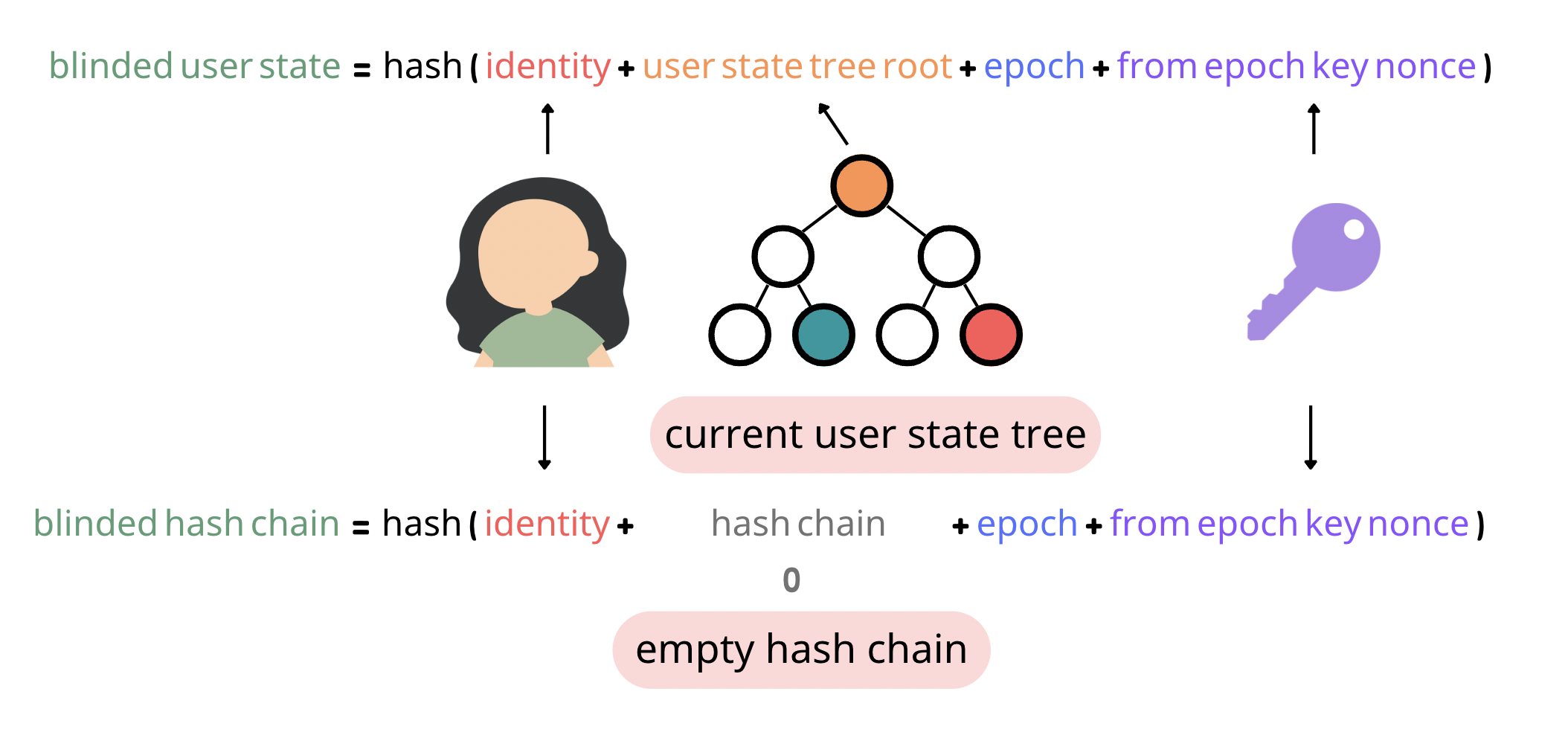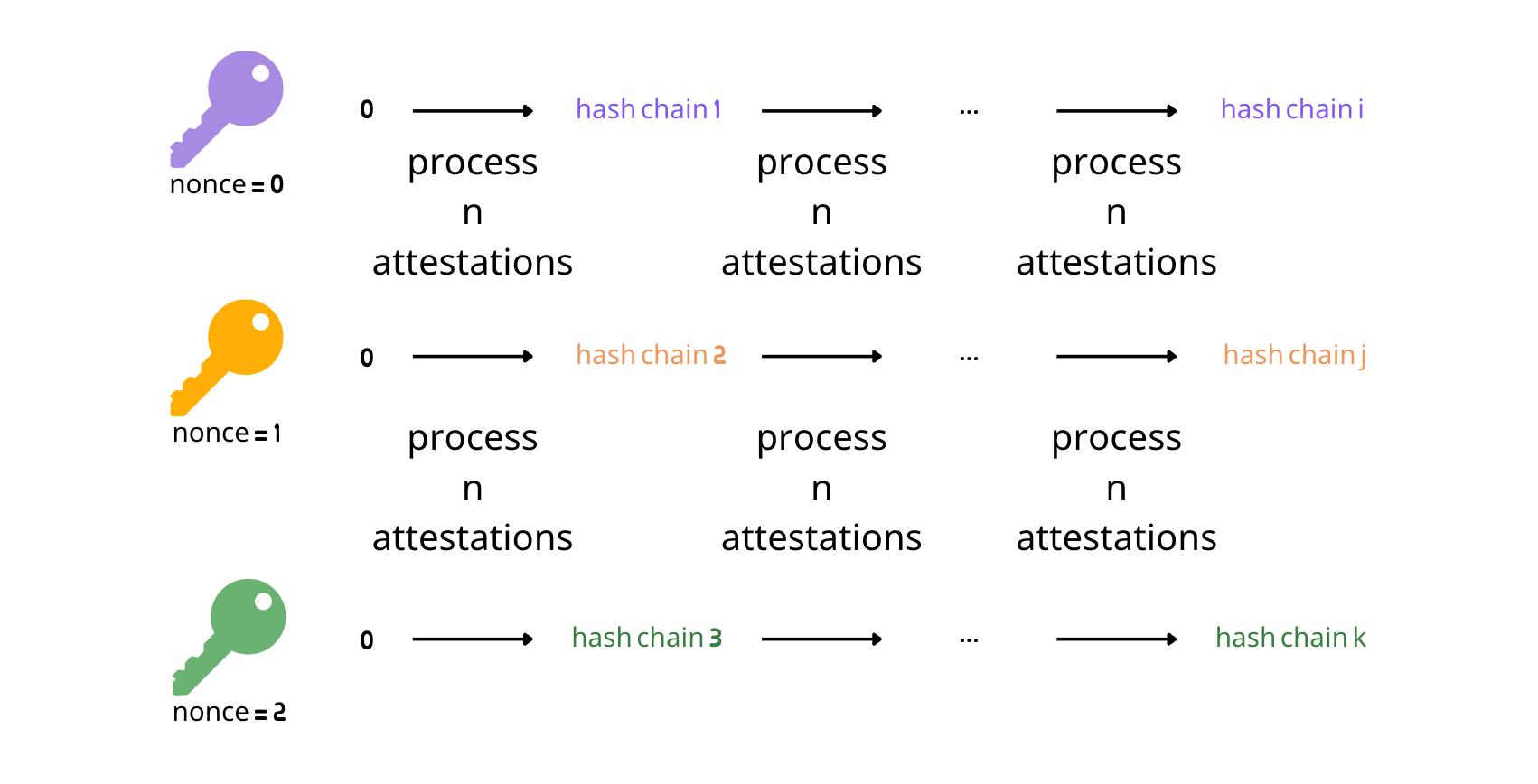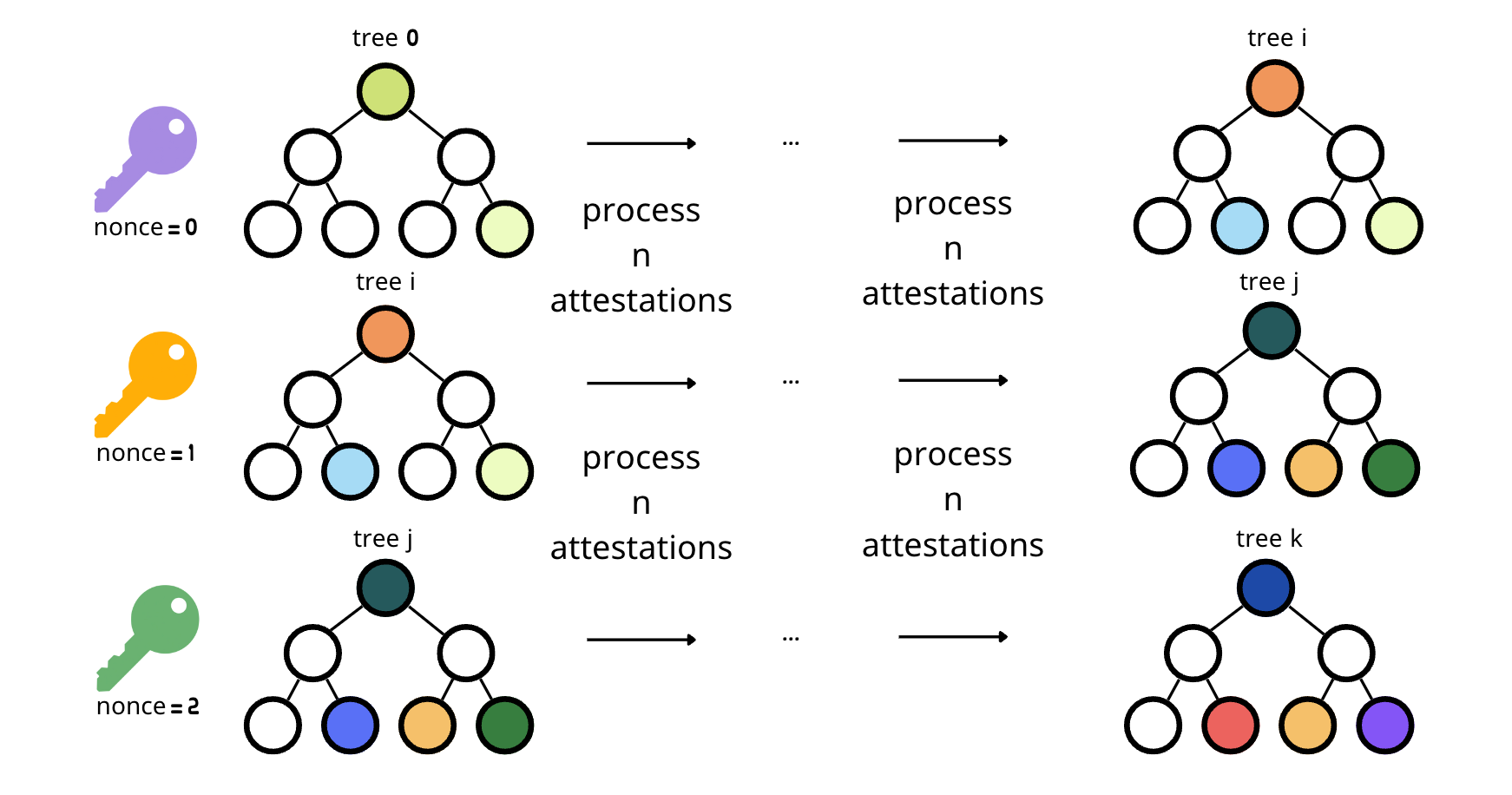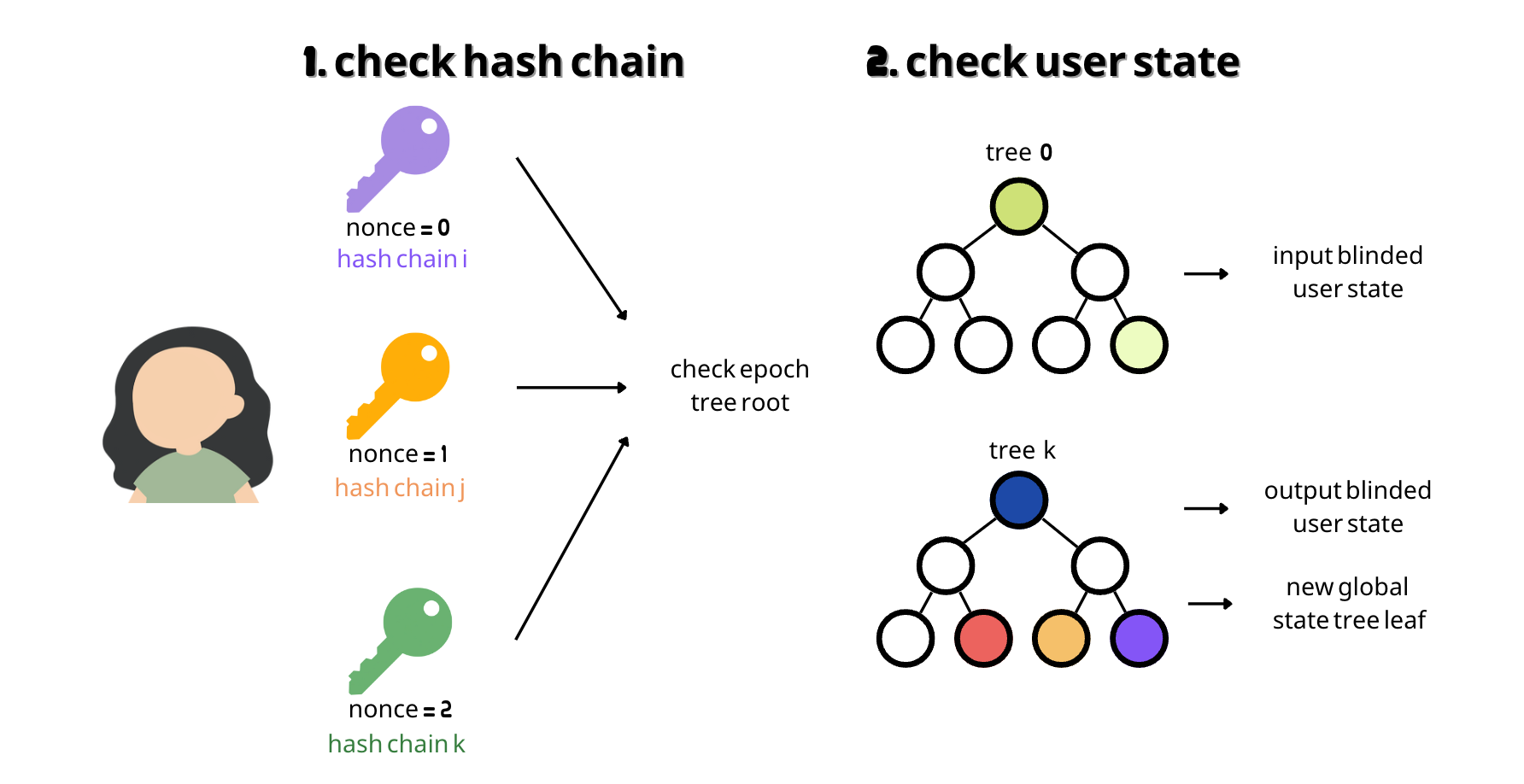User State Transition Proof
The user state transition proof is used to process attestations from the latest epoch the user transitioned and then compute the latest global state tree leaf.
The user state transition circuit checks that
The user has registered and performed user state transition in the previous epoch.
The user state tree is updated correctly by the attestations, and the same attestations are chained by hash functions.
- For example, the original user state tree root is
r_1, and the original user state tree leaf has 5 positive reputation
user_state_tree_leaf = hash(5, 0, 0, 0, 0)- An incoming attestation has
attester_id = 1pos_rep = 3
- compute the hash of reputation
hash_reputation = hash(5 + 3, 0, 0, 0, 0)- compute the updated user state tree root
r_2with user state tree leafhash(8, 0, 0, 0, 0)in the leaf index1 - compute the hash of attestation
hash_attestation = hash(1, 3, 0, 0, 0)- compute the hash chain
hash_chain = hash(hash_attestation, hash_chain)- For example, the original user state tree root is
After all attestations of all epoch keys are processed, the circuit seals all hash chains and computes the epoch tree. (If the output epoch tree root mismatches others' epoch tree roots, then the user state transition proof is invalid because the user process attestations in a wrong way.)
Compute the updated global state tree leaf by
hash(identity_commitment, updated_user_state_root)
Ideally, the user state transition proof should be in one circuit. But the circuit size is too big to generate a proof in a browser, we separate the proof into three different parts: start transition proof, process attestations proof, and user state transition proof.
The idea of chaining these three proofs but without revealing user's sensitive information is to use blinded_user_state and blinded_hash_chain
const blinded_user_state = hash(
identity_nullifier,
user_tree_root,
epoch,
from_epoch_key_nonce
)
const blinded_hash_chain = hash(
identity_nullifier,
current_hash_chain,
epoch,
from_epoch_key_nonce
)
In the start transition proof, the circuit will compute the initial blinded_user_state and blinded_hash_chain, the user_tree_root is the latest transitioned user state tree and the hash(identity_commitment, updated_user_state_root) should be in a global state tree. The current_hash_chain is start with 0 as the definition of hash chain.

After blinded_user_state and blinded_hash_chain are submitted, the user can take them as public inputs and start to process attestations according to the user_tree_root and current_hash_chain. When the attestations limit reaches (e.g. a processAttestations circuit can process only 10 attestations per proof) or all attestations to the epoch key are processed, the circuit will output another blinded_user_state and blinded_hash_chain to continue processing attestations.


The epoch_key_nonce is used in the blinded user state and blinded hash chain to indicate the attestations of which epoch key is processed. In the final userStateTransition proof, it checks all epoch key with different epoch_key_nonce are processed and the hash chain result matches the epoch tree.
There are only one user state tree result after all attestations are processed, so in the final proof it only takes the initial blinded_user_state and the final one and computes the new global state tree leaf. On the other hand, there are numEpochKeyNoncePerEpoch hash chains after processing attestations, so the final circuit will take numEpochKeyNoncePerEpoch blinded_hash_chain to check the epoch tree root.

The user state tree root is continuously updated: the output should be the input of another proof, so the processAttestation proof takes blinded_user_state as public input and output another blinded_user_state. The hash chain results might not be continuously. When all attestations of one epoch key is processed, the hash chain of the next epoch key should be 0 but not the previous hash chain. Therefore, processAttestation proof does not take blinded_hash_chain as input.
While verifying all of the proofs, there are the following things to check to make sure it follows the rules:
startTransitionProoftakes a valid global state tree root as a public input.processAttestationsProoftakesblinded_user_stateas public input andblinded_hash_chainas private input from eitherstartTransitionProofor anotherprocessAttestationsProof.userStateTransitionProoftakes twoblinded_user_state, one is fromstartTransitionProofand the other is from the latestprocessAttestationsProof.userStateTransitionProoftakesnumEpochKeyNoncePerEpochblinded_hash_chainfromprocessAttestationsProof.
1. Start Transition proof
Public outputs
GST_rootblinded_user_stateblinded_hash_chain_result
Private inputs
epochepoch_key_nonceuser_tree_rootidentity_nullifieridentity_trapdoorGST_path_elementsGST_path_index
Contraints
1. Check if user exists in the Global State Tree
Check if hash(identity_commitment, UST_root) is one of the leaves in the global state tree of root GST_root.
2. Compute blinded public output
const blinded_user_state = hash(
identity_nullifier,
user_tree_root,
epoch,
from_epoch_key_nonce
)
const blinded_hash_chain = hash(
identity_nullifier,
current_hash_chain,
epoch,
from_epoch_key_nonce
)
See the whole circuit in circuits/startTransition.circom
2. Process attestations proof
Public inputs
input_blinded_user_state
Public outputs
blinded_user_stateblinded_hash_chain_result
Private inputs
epochfrom_nonceto_nonceidentity_nullifierintermediate_user_state_tree_rootsold_pos_repsold_neg_repsold_graffitiesold_sign_upspath_elementsattester_idspos_repsneg_repsgraffitiesoverwrite_graffitiessign_upsselectorshash_chain_starter
Contraints
1. Verify blinded input user state
Check if
const input_blinded_user_state = hash(
identity_nullifier,
intermediate_user_state_tree_roots[0],
epoch,
from_nonce
)
2. Verify attestation hash chain
Check if
const current_hash_chain = hash(
hash(
attester_ids[i]
pos_reps[i],
neg_reps[i],
graffities[i],
sign_ups[i]
),
prev_hash_chain
)
3. Process attestations and update user state tree
Check intermediate_user_state_tree_roots[i] has leaves
hash(
old_pos_reps[i],
old_neg_reps[i],
old_graffities[i],
old_sign_ups[i]
)
with index attester_ids.
And update the leaf by
new_pos_reps[i] = pos_reps[i] + old_pos_reps[i]
new_neg_reps[i] = neg_reps[i] + old_neg_reps[i]
if (overwrite_graffities[i]) {
new_graffities[i] = graffities[i]
} else {
new_graffities[i] = old_graffities[i]
}
new_sign_ups[i] = sign_ups[i] || old_sign_ups[i]
And the new leaf
hash(
new_pos_reps[i],
new_neg_reps[i],
new_graffities[i],
new_sign_ups[i]
)
Should be one of the leaves in intermediate_user_state_tree_roots[i+1] with index attester_ids[i].
4. Compute blinded public output
const output_blinded_user_state = hash(
identity_nullifier,
intermediate_user_state_tree_roots[n+1],
epoch,
to_nonce
)
const output_blinded_hash_chain = hash(
identity_nullifier,
current_hash_chain,
epoch,
to_nonce
)
See the whole circuit in circuits/processAttestations.circom
3. User State Transition proof
Public inputs
epochblinded_user_stateblinded_hash_chain_resultsepoch_tree_root
Public outputs
GST_rootnew_GST_leafepoch_key_nullifier
Private inputs
intermediate_user_state_tree_rootsstart_epoch_key_nonceend_epoch_key_nonceidentity_nullifieridentity_trapdoorGST_path_elementsGST_path_indexepk_path_elementshash_chain_results
Contraints
1. Check if user exists in the Global State Tree
Check if hash(identity_commitment, UST_root) is one of the leaves in the global state tree of root GST_root.
2. Process the hashchain of the epoch key specified by nonce n
Get all blinded hash chains with nonce iterates from 0 to n-1
const output_blinded_hash_chain = hash(
identity_nullifier,
hash_chains[i],
epoch,
i
)
Seal all hash chains
const sealed_hash_chain = hash(1, hash_chains[i])
Check the epoch tree root with epoch_keys[i] and hash_chains[i].
3. Check if blinded user state matches
Output two blinded user states with start_epoch_key_nonce and end_epoch_key_nonce.
const output_blinded_user_state[0] = hash(
identity_nullifier,
intermediate_user_state_tree_roots[0],
epoch,
start_epoch_key_nonce
)
const output_blinded_user_state[1] = hash(
identity_nullifier,
intermediate_user_state_tree_roots[1],
epoch,
end_epoch_key_nonce
)
4. Compute and output nullifiers and new GST leaf
const new_GST_leaf = hash(
id_commitment,
intermediate_user_state_tree_roots[1]
)
See the whole circuit in circuits/userStateTransition.circom